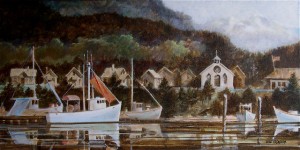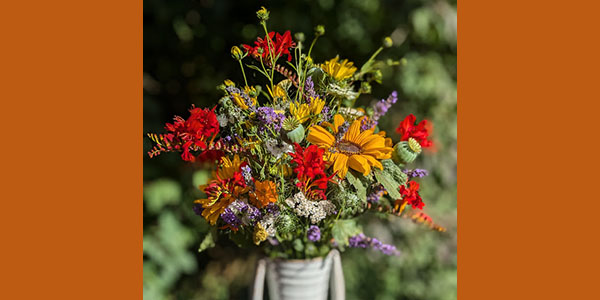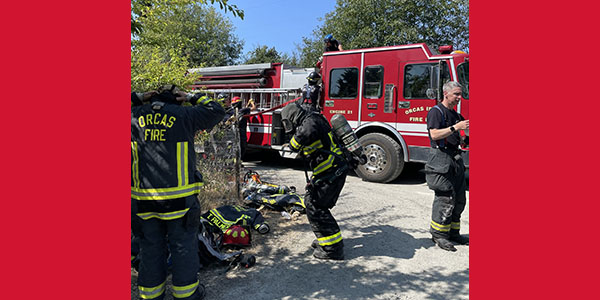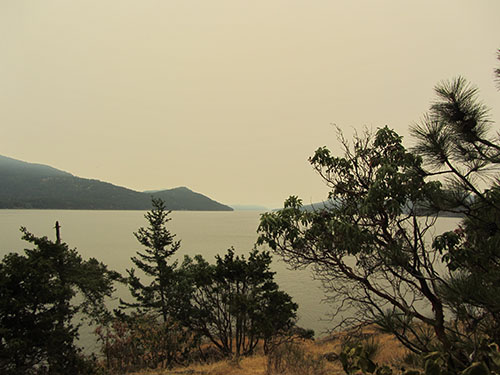
"Hoonah Village on Icy Straits, Alaska" one part of a triptych by William Trogdon, to be displayed with works by other local artists in "Our Vast Landscapes" at the Orcas Center.
Show opens with reception this Friday
Island artists Bill Trogdon, Anne Pedersen, Pam Jenkins and Gail Johannes describe their process
Summer brings forth our island surroundings in full, glorious color. Fields are golden, trees are green and skies are blue – perfect for an artist’s canvas. That was in the mind of Orcas Center and the Visual Arts Committee when it planned its August show, “Our Vast Landscapes”.
Karen Speck, Show Director said, “I am very excited about the art that will be on display at Orcas Center in August. Landscapes are my favorite subject, and the wide variety of choices depicting our great land will be amazing.”
Over thirty artists are participating and over sixty works will be on display in the Orcas Center Lobby Gallery and Madrona Room Gallery.
The show opens Friday, July 31, with a food-and-music reception from 5:30 to 7 p.m. at Orcas Center. Everyone is invited to attend and meet the artists. The show runs through Sept. 1 and is free.
Speck is particularly pleased to feature a work by Orcas resident William Trogdon. “Bill has painted a fabulous triptych of three panels … each,” said Speck. “The panels can stand alone as individual works. All three will be on display, revealing a beautiful shoreline, boat harbor and mountain scene.” The work is titled “Hoonah Village on Icy Straits, Alaska” and is done in acrylic.
Trogdon, who studied art and engineering before turning to a career in architecture, said his painting interests began with watercolor enhancement of architectural renderings.
After 30 years practicing architecture in Spokane and further work in Seattle, he began studying with art instructor Terry Johnson about five years ago. Trogdon, who has been on many architectural design juries, says that Johnson “has taught me to look and think and critique as an artist rather than an architect.”
After studying drawing for several years, Trogdon moved to oil painting and has recently begun working in acrylics.
Trogdon doesn’t regularly show his paintings, but relies on the critiques offered in Johnson’s classes. “We sort of feed on each other as far as art, and help each other.” Currently they are studying life drawings, “trying to get the body to show what’s underneath the skin a little,” says Trogdon. He has previous worked in graphite and charcoal in the life drawings, and finds the experiment in painting “a challenge – landscape painting is easy.”
His travels in Europe and around the U.S. have informed his landscapes, as the triptych of Hoonah illustrates. He paints in his travel journals, from recall of the sights he has seen during the day. “It’s a great exercise, I get more abstract and suggestive,” said Trogdon.
“I’m still trying to find where I am with my work, still the challenge to paint something that I like and that people like. As we sit back and comment on each others’ work, we point out what’s good, If it’s all good – hooray!”
Anne Petersen will be displaying two landscapes that she painted in Santa Barbara, where she now spends part of each year after living on Orcas for 25 years.
Petersen paints in oils, and enjoys both plein air and studio painting. Previously she painted in watercolors, and has also done weaving and ceramics, as well as writing her personal history. “I’ve always been pulled to putting my line on paper,” she says.
Anne paints for her own enjoyment, rather than exhibiting per se, but she says, “You can stockpile only so much of your work. You paint as much as you can, always learning from the masters, honing in on your path to finding the unique expression that’s just yours. They’re studies as you work to find your own voice. At the end, it’s up to you as to how you want to approach your subject and it comes down to painting for yourself.
“Expression is always a mystery and [as you paint] you ask yourself, ‘Why am I here?’ It gets you up and going to classes and studios.
“The push is always to get out there. You’re never done. I see myself as still growing; I want to be painting till I drop and if I see myself as ‘there,’ it will all be over,” says Petersen.
Orcas Kindergarten teacher Pam Jenkins finds little time to paint during the school year, but during summers and the occasional school year weekend, she attends classes and produces most of her paintings.
For “Our Vast Landscapes” she has entered the award-winning “Jubilant Madronas,” and a landscape of the bluff at Crescent Beach for the landscape show. Working with soft pastels, she describes her paintings as a “kind of drawing.”
“I love color and light and landscapes – I love what happens with light and shadow, says Jenkins. She often paints from photographs taken on Orcas, in the Skagit and Yamhill valleys and in Tuscany.
She has submitted her paintings for juried shows, and been exhibited at the NW Pastel Society Show, the Blue Horse Gallery in Bellingham and the Washington Convention Center in Seattle, as well as at the Orcas Center.
While she keeps a few of her paintings for herself, and has donated paintings to fundraisers, she says, “I like to paint and don’t want to have a bunch of paintings around. It’s fun to sell them and send them off and keep track of where my paintings are – in Florida, Texas, Washington D.C. and North Carolina.”
Gail Johannes will be exhibiting her photographs for “Our Vast Landscapes.” Johannes has drawn and painted in watercolor and gouache (a “watercolor with opacity – in and of itself a beautiful medium,”) and first began to explore photography to provide subjects for paintings.
Her photography developed along with digital techniques, and “sped up the learning curve” of her photography, and she now finds “shooting is more fun than painting” Her landscape of Madrona Point from Crescent Beach uses HDR or “High Dynamic Range” photography, a combination of camera technique and editing software.
Johannes describes the perspective of her photography: “I look through a filter of shapes and values, not so much the subject matter. It’s spatial rather than objective.” Often as she works with the resultant photographs, she thinks, ‘Oh my gosh, who knew?’
Many of the works exhibited at “Our Vast Landscapes” will be for sale and when sold, a percentage benefits the Orcas Center.






